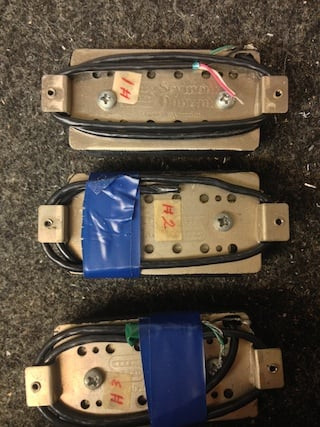Dimebag Darrell, the guitar icon who redefined metal with Pantera and Damageplan, remains a figure of immense fascination for guitarists worldwide. His quest for the ultimate tone was relentless, a journey witnessed firsthand by his guitar tech, Grady Champion, who worked alongside Dime for 13 years. Champion’s insights reveal the crucial role of pickups in Dimebag’s signature sound, particularly his relationship with Seymour Duncan and the development of the now-legendary Dimebucker pickup. While the Dimebucker became synonymous with Dime’s aggressive bridge tone, Champion unveils a lesser-known secret: Dimebag’s fondness for the Seymour Duncan ’59 Model in the neck position of his guitars, showcasing his nuanced approach to crafting his sonic landscape.
Champion recalls Dimebag’s constant experimentation with pickups, a never-ending search for “a little more gain.” This relentless pursuit led him to try countless combinations, always pushing the boundaries of his guitar’s sonic capabilities. While Bill Lawrence pickups held a prominent place in Dime’s bridge position for many years, his desire for a neck pickup with more bite led him to the ’59 bridge model. This unconventional choice highlights Dimebag’s willingness to explore beyond typical configurations and his intuitive understanding of how different pickups could contribute to his overall sound. It wasn’t just about brute force; it was about sculpting a tone that was both aggressive and articulate.
The story of the Dimebucker’s creation further illuminates Dimebag’s hands-on approach. Seymour Duncan sent Dimebag prototypes of the Dimebucker, and in true Dime fashion, he turned the testing process into a nightly experiment. Champion describes swapping pickups in Dime’s “Cowboys from Hell” guitar each night, allowing Dime to evaluate them in a live performance context – the ultimate proving ground. Dimebag’s feedback, shaped by his demanding stage environment and perhaps, as Champion humorously suggests, the effects of “eight 4×12’s blowing your head off,” directly influenced the final voicing of the Dimebucker. This anecdote underscores how Dimebag’s real-world experience and unique auditory perception were integral to the pickup’s design, ensuring it delivered the extreme, cutting tone he craved.
 Seymour Duncan Dimebag Darrell Dimebucker prototypes
Seymour Duncan Dimebag Darrell Dimebucker prototypes
Original Dimebucker prototypes developed for Dimebag Darrell’s signature guitar, showcasing Seymour Duncan’s commitment to crafting his unique tone.
Delving deeper into the interplay between the Dimebucker and the ’59 Model, Champion emphasizes Dimebag’s preference for “hot” tones across the spectrum. While the ’59 Model is often associated with vintage-voiced blues and rock, Dimebag recognized its potential to add edge and aggression in the neck position. This combination of the Dimebucker’s aggressive attack in the bridge and the ’59’s hotter-than-vintage neck tone created a versatile sonic palette. It allowed Dimebag to move seamlessly between searing leads and thick, rhythmically complex riffs, all while maintaining his signature aggressive edge. This pairing wasn’t just about volume; it was about achieving a balanced yet powerful tonal foundation for his dynamic playing style.
Beyond pickups, Dimebag’s guitars were canvases for constant personalization. Champion details a range of modifications, from soldering iron-modified volume knobs for enhanced grip to tape strategically placed to prevent string snags. Foam inserts dampened unwanted spring noise and behind-the-nut foam further refined the instrument’s resonance. Even Dimebag’s signature .88 Tortex picks weren’t spared from customization, scratched with a dart for improved grip. These seemingly minor tweaks reveal Dimebag’s meticulous attention to detail and his understanding of how even small adjustments could enhance his playing experience and contribute to his overall performance. His guitar was an extension of himself, meticulously tailored to his specific needs and preferences.
 dimebag knobs
dimebag knobs
Modified volume knobs on Dimebag Darrell’s Dean ML guitar, illustrating his personalized approach to his instrument’s hardware for enhanced control.
Despite the intense focus on gear, Champion dispels the myth that Dimebag’s tone was solely equipment-dependent. He stresses the “magical formula” was Dimebag himself – his hands, his technique, his unique musicality. While Dime’s rig was undoubtedly powerful, Champion points out that his guitar action wasn’t exceptionally low, and his gain was incredibly sensitive, requiring precise control. This highlights the crucial role of Dimebag’s dynamic playing style and nuanced touch. Simply replicating his gear settings wouldn’t magically conjure his sound; it was Dimebag’s unique approach to the instrument that truly defined his iconic tone. His gear served as “good ole tools,” expertly wielded by a master craftsman.
Anecdotes further emphasize this point. Champion recounts stories of other guitarists, including Anthrax’s Scott Ian, being overwhelmed by the sheer gain of Dimebag’s rig. Another story illustrates Dimebag’s powerful playing style: when Paul Crook, then Anthrax’s guitarist, lent Dime his guitar, Dime’s immediate whammy dive resulted in ripping the Floyd Rose tremolo from the guitar’s body. These stories serve to underscore the symbiotic relationship between Dimebag and his guitars. His gear was built to withstand his aggressive playing, and his hands were the driving force behind his unmistakable sound.
 Dimebag Darrell
Dimebag Darrell
Dimebag Darrell, a true guitar innovator, whose legacy continues to inspire generations of musicians to explore their own sonic boundaries.
In conclusion, Dimebag Darrell’s guitar tone was a product of relentless experimentation, meticulous personalization, and, most importantly, his unique musical genius. The Dimebucker pickup, born from his collaboration with Seymour Duncan, became a cornerstone of his aggressive bridge sound, while his use of the ’59 Model in the neck revealed a more nuanced approach to tone shaping. However, as Grady Champion aptly states, Dimebag himself was the true “magical formula.” His gear was an extension of his artistry, tools that he masterfully employed to create a sound that remains instantly recognizable and eternally influential in the world of metal guitar.
